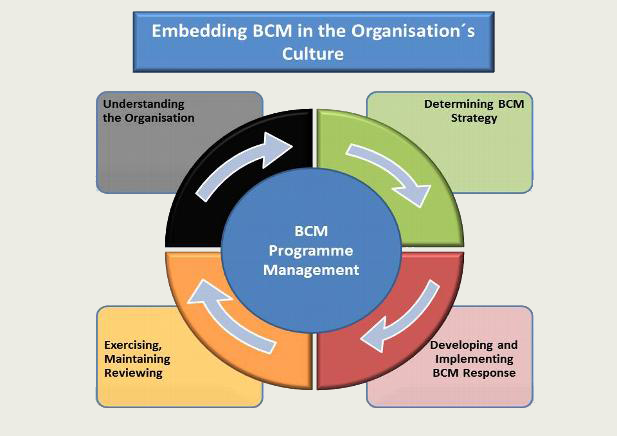Business Continuity Management
In accordance with British Standard BS25999 and ISO 22301:2012 Business Continuity Management (BCM) is a holistic process that identifies potential threats to an organization and the impacts to business operations that those threats, if realized, might cause. It provides a framework for building organizational resilience with the capability for an effective response that safeguards the interests of key stakeholders, reputation, brand and value-creating activities.
Source: BCI Good Practice Guidelines 2010
In the framework of Integrated Risk Management, BCM is a reactive component that requires pro-active and preventive risk management and the implementation of measures that have been derived. In other words, BCM describes strategies and measures, that apply, after all preventive measures have failed.
BCM and Crisis Management

© FEMA Foto News.
The link between Crisis Management and Incident Management is that BCM considers any disruption holistically and determines how an organization will respond to the disruption, continue its activities and recover. BCM practitioners consider the media response to an incident or crisis to be an integral part of a full Business Continuity programme.
Source: BCI Good Practice Guidelines 2010
BCM und Incident Response
Related again to Incident Management is Emergency Planning. The difference here is that Emergency Planning is normally seen as the domain of „blue light services“ such as police, fire brigade, ambulance and local authorities rather than for organizations in general, where the incident team, typically, would co-ordinate with the emergency response teams.
© Dr. Bellof Consulting
The "BCM-LifeCycle" is defined by ISO 22301:2012 and the "Good Practice Guidelines of the Business Continuity Institutes (BCI). As shown in the graph, the implementation cycle starts with the elaboration of company specific policies and basic principles, followed by identification of business critical processes and their interdependencies. The Business Impact Analysis (BIA) will subsequently identify the time-dependend consequences, if these processes should be disrupted. A Risk Analysis will ensure that all aspects necessary to understand the organization have been addressed. Development of BC strategies will come next, followed by conception and implementation of appropriate measures. Training of the staff, archiving and regular revision of the documentation will complete the BCM-Cycle.
|
Dr. Bellof Consulting will be happy to support you with the establishment
of your Business Continuity Management Systems (BCMS) right from the start or, if preferred,
with an assessment, to check the degree of actuality of your current Business Continuity Management System (BCMS).
If we should have aroused your interest or if there is any need for action, please don´t hesitate to contact us for further information and support. We can draw from vast backgrounds of more than 15 years of experience in implementation, management, training and education of Business Continuity Management in the pharmaceutical industry. Please contact us. |


